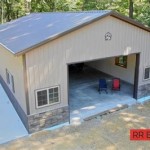A Comprehensive Guide to Garage Door Mouldings
Garage door mouldings, also known as trim, play a significant role in enhancing the aesthetics and functionality of your garage door. They add a finished look, protect the door from damage, and help with weather sealing. Understanding the different types of garage door mouldings, their benefits, and installation methods enables homeowners to make informed decisions about their garage door design and maintenance.
Types of Garage Door Mouldings
Garage door mouldings come in various materials, styles, and sizes, each offering unique advantages. Here are some common types:
1. J-Channel Moulding
J-channel moulding is a versatile and commonly used option. It features a J-shaped profile that fits snugly over the garage door panel edges. This moulding provides protection against bumps and scratches while enhancing the door's overall appearance. J-channel mouldings are typically made from aluminum, vinyl, or wood.
2. Beadboard Moulding
Beadboard moulding offers a classic and elegant look. It features raised vertical lines, resembling a beadboard paneling design. Beadboard mouldings are often used to add a decorative touch and enhance the visual appeal of the garage door. They are typically made from wood or composite materials.
3. Flush Moulding
Flush moulding provides a sleek and modern aesthetic. It is installed flush with the garage door panel, creating a clean and unobstructed look. Flush mouldings are often preferred for contemporary home styles and can be made from aluminum, vinyl, or wood.
4. Decorative Moulding
Decorative mouldings come in a wide array of styles and designs, allowing homeowners to personalize their garage doors. These mouldings can incorporate intricate patterns, carvings, or accents to create a unique and eye-catching design. Decorative mouldings are typically made from wood or composite materials.
Benefits of Garage Door Mouldings
Beyond aesthetics, garage door mouldings offer numerous benefits:
1. Protection and Durability
Mouldings act as a protective barrier, shielding the garage door panels from bumps, scratches, and dents. This is especially important for doors that are frequently used or exposed to harsh weather conditions.
2. Enhanced Weather Sealing
Mouldings can improve the weather sealing of your garage door. They create a tight seal around the door panels, preventing drafts, rain, and moisture from entering the garage. This can help to maintain a comfortable temperature inside the garage and protect your belongings from damage.
3. Noise Reduction
Mouldings can help to reduce noise transmission from the garage door. The tight fit of the mouldings against the panels minimizes vibrations and sound absorption, creating a quieter garage environment.
4. Improved Aesthetics and Curb Appeal
Garage door mouldings can significantly enhance the overall aesthetics of your garage door and improve your home's curb appeal. They add a finished look, create visual interest, and complement your home's architectural style.
Installation Tips
Installing garage door mouldings is a relatively straightforward DIY project. However, it's essential to follow the correct steps to ensure a proper and secure installation. Here are some general tips:
1. Prepare the Surface
Before installing mouldings, clean the garage door surface thoroughly to remove any dirt, grime, or debris. Ensure the surface is smooth and free of bumps.
2. Measure and Cut
Accurately measure the areas where you will be installing the mouldings. Use a measuring tape and a sharp utility knife to cut the mouldings to the desired lengths.
3. Apply Adhesive
Apply a high-quality adhesive to the back of the mouldings. Make sure the adhesive is evenly distributed and spread according to the manufacturer's instructions.
4. Secure with Clips or Screws
Some mouldings may require clips or screws for additional support. If using screws, ensure they are the appropriate length and drill pilot holes to avoid splitting the wood.
5. Finish the Installation
Once the mouldings are installed, use a putty knife or scraper to smooth out any excess adhesive and ensure a seamless finish. You may also need to caulk any gaps or cracks to enhance the weather sealing.

Comprehensive Guide To Garage Doors Champion Door Repair

The Complete Guide To Swing Out Garage Doors 2025

Building Pvc Door Trim For Garage Entry Doors

Replacing Garage Door Trim A Comprehensive Diy Guide

Detailed Garage Door Installation Instructions

Garage Door Materials A Comprehensive Guide To Exploring And Comparing Diffe Material Options

Garage Door Jambs Best Material For Openings

Interior Garage Door Framing Clopay

Comprehensive Guide On The Safest Types Of Garage Doors

Garage Door Anatomy Parts Of A Explained
Related Posts








